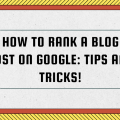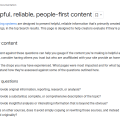In today’s digital landscape, crafting content that resonates with both your audience and search engines is paramount. This dual-focused approach to writing ensures your content not only engages and informs but also ranks well, driving organic traffic to your site. Whether you’re a digital marketer, content creator, or an SEO beginner, these 10 practical steps will guide you through the process of creating content that meets the needs of users while satisfying search engine algorithms.
Table of Contents
Step 1: Understand Your Audience
The foundation of effective content lies in a deep understanding of your audience. Start by building personas that reflect your target readers. Consider their demographics, interests, pain points, and search intent. Tools like Google Analytics and social media insights can provide valuable data to help create these personas. Knowing your audience enables you to tailor your content’s tone, style, and substance, making it more engaging and relevant.
Step 2: Conduct Keyword Research
Keyword research is the compass that guides your content strategy. It reveals what your audience is searching for and the language they use. Utilize tools like Ahrefs, SEMrush, and Google Keyword Planner to identify high-value keywords related to your topic. Look for a mix of head terms and long-tail keywords, as they will help you balance broad appeal with specific search intents.
Step 3: Create a Structured Outline
Organize your thoughts and research findings into a clear, logical structure before you begin writing. An outline serves as a roadmap, ensuring your content flows smoothly and covers all necessary points. It should include an introduction that hooks readers, body sections that offer substantial information, and a conclusion that summarizes key takeaways.
Step 4: Write Compelling Headlines and Titles
Your headline is the first impression readers—and search engines—have of your content. Make it count by creating titles that are both informative and enticing. Incorporate primary keywords while sparking curiosity or offering value. Helpful tools like CoSchedule’s Headline Analyzer can assess the effectiveness of your titles.

Step 5: Prioritize Readability
User-friendly content is readable content. Break down complex ideas into digestible chunks. Use short paragraphs, bullet points, and subheadings to organize information. Incorporating multimedia, such as images and videos, can also enhance readability, making your content more appealing to both users and search engines.
Step 6: Optimize for SEO Without Overstuffing
While keywords are crucial for SEO, natural inclusion is key. Keyword stuffing can harm readability and penalize your rankings. Instead, strategically place your primary keyword in the title, headings, and throughout the text in a way that feels natural. Also, don’t forget to optimize your meta descriptions, URLs, and alt tags with relevant keywords.
Step 7: Provide Value Through Rich Content
Quality content addresses users’ questions and provides valuable insights. Go beyond the surface level by offering in-depth explanations, examples, and case studies. Check your content for plagiarism as well as AI-generated elements using free and reliable software like Attrock AI content detector to further reinforce its originality and quality. Using reputable sources to back your claims not only strengthens your content’s credibility but also its appeal to search engines that prioritize authoritative and informative content.
Step 8: Encourage Engagement
Engagement signals, like comments and shares, are positive indicators to search engines. End your posts with a call-to-action (CTA) encouraging readers to engage, share their thoughts, or explore related content. Interactive elements, such as polls or quizzes, can also boost engagement.
Step 9: Leverage Internal Linking
Internal linking keeps users on your site longer, reducing bounce rates and improving your site’s SEO performance. Link to relevant articles or pages within your site to provide readers with additional value and encourage deeper exploration of your content.
Step 10: Continuously Update Your Content
The digital landscape is always evolving, and so should your content. Regularly review and update your posts to ensure they remain accurate, relevant, and optimized for the latest search engine algorithms. This practice can help maintain or improve your content’s search rankings over time.
Final Thoughts
Writing for both users and search engines is a balancing act that requires strategy, creativity, and ongoing optimization. By following these 10 steps, you can create content that not only ranks well but also genuinely resonates with your readers. Remember, at the core of successful content is the value it provides—to both your audience and search engines.
In crafting your strategy, always keep the user experience at the forefront. Engaging, valuable, and accessible content will naturally perform better in search rankings, as search engines continually refine their algorithms to prioritize the user’s needs. Stay informed about the latest SEO trends and updates, but remember, quality content that serves your audience’s interests and needs is timeless.
By adopting these practices, you’ll not only improve your content’s performance in search results but also build trust and authority with your audience, laying the foundation for long-term digital marketing success.























